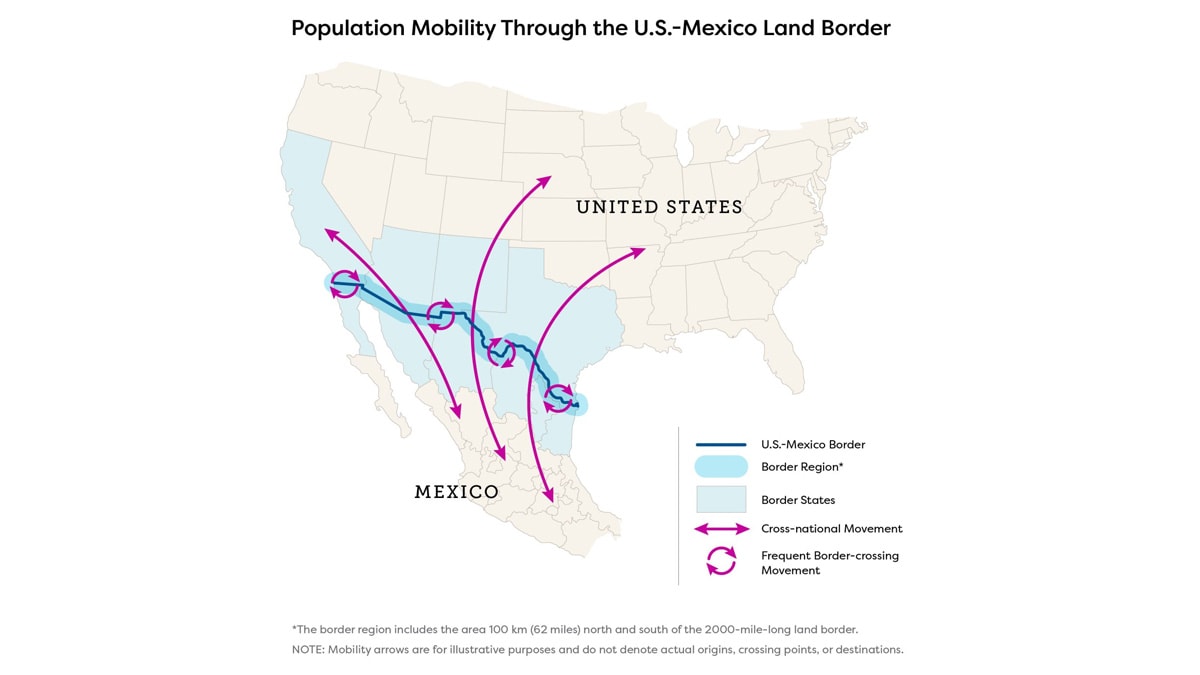Key points
- The U.S. and Mexico are connected through border and binational communities that share social and environmental conditions. This connectedness affects communicable disease risks.
- CDC works with U.S.-Mexico partners to prevent and control disease spread across borders, and protect the health of border residents, binational communities, and other mobile populations.

Overview
The United States and Mexico share a dynamic history of social, cultural, and economic ties. People travel between the United States and Mexico to visit, work, and live. Large volumes of people and products constantly move between the two countries, influencing the environment, economies, and health of people in both countries. This inter-connectedness creates binational communities of people who live throughout the United States and Mexico.
There are unique challenges and opportunities for preventing the spread of infectious diseases in the border regionA and binational communities. Public health agencies from both countries work together on shared health challenges.

Terms to know
U.S.-Mexico border health refers to health consequences, issues, and risks that affect people who live in or transit through the border region. It addresses factors related to cross-border connectedness, including personal contact, travel or migration, or exposure to products or environmental conditions from each neighboring country.
U.S.-Mexico binational health refers to the health consequences, issues, and risks affecting the communities throughout the United States and Mexico that have close social ties to, travel between, and consumption of products from both countries.
Facts
Border Crossings
- There were 187.8 million northbound border crossings at official land ports of entry1 in 2023.
Tourism
- Mexico is a top foreign tourist destination for U.S. travelers and the United States is the primary destination for Mexican travelers.2
- In 2023, 29.5 million people traveled from the United States to Mexico3 and 16.1 million from Mexico to the United States4.
Border Region Residents and Expatriates
- In 2020, 8 million people lived in the U.S. border region5 and 8.8 million lived in the border region of Mexico6.
- Mexico is the number one country of residence for U.S.-born persons living outside of the United States. In 2020, 799,000 U.S. citizens lived in Mexico7.
- In 2021, the United States was home to 10.7 million people born in Mexico8 and in 2022, 37.4 million people with Mexican heritage9, many born in the U.S.
Temporary Workers
- About 560,000 seasonal agricultural workers and almost 100,000 seasonal non-agricultural workers from Mexico10 came to the United States for temporary work in 2021.
Trade
- Mexico is the United States’ largest agricultural trading partner11 in terms of combined exports and imports.
- In 2021, Mexico accounted for 15.5% of U.S. agricultural exports and 22.3% of U.S. agricultural imports11.
What CDC is doing
CDC's Division of Global Migration Health's, Southern Border Health and Migration Branch collaborates with health officials in the United States and Mexico at local, state, and federal levels to prevent, detect, and respond to infectious diseases that impact the health of U.S.-Mexico border region, binational populations, and other mobile populations.
- The U.S.-Mexico border region is made up of 44 counties across four U.S. states and 80 border municipios across six Mexican states within 100 km (62 miles) of the 2000-mile-long international border line.
- U.S. Customs and Border Protection, Traveler and Conveyance Statistics
- U.S. Department of Commerce, International Trade Administration National Travel and Tourism Office, International Visitation to and from the United States
- U.S. Department of Commerce, International Trade Administration U.S. International Air Travel Statistics
- U.S. Department of Commerce, International Trade Administration Mexico Travel and Tourism
- U.S. Census Bureau, County Population Totals and Components of Change: 2020-2022
- National Institute of Statistics and Geography (INEGI), Consultation System for Territorial Integration (SCITEL) [Spanish]
- Migration Policy Institute, Immigrant and Emigrant Populations by Country of Origin and Destination
- Migration Policy Institute, Mexican Immigrants in the United States
- Pew Research Center, Key facts about U.S. Latinos, 2023
- U.S. Department of Homeland Security, Nonimmigrant Admissions
- U.S. Department of Agriculture, Economic Research Service, Mexico: Trade & FDI
